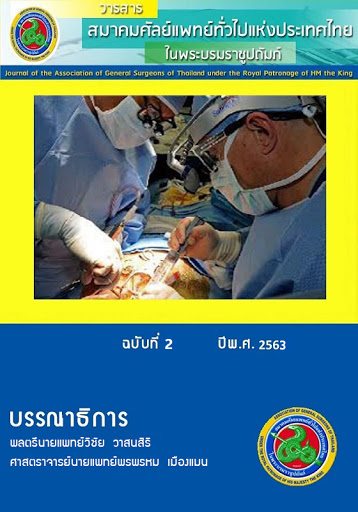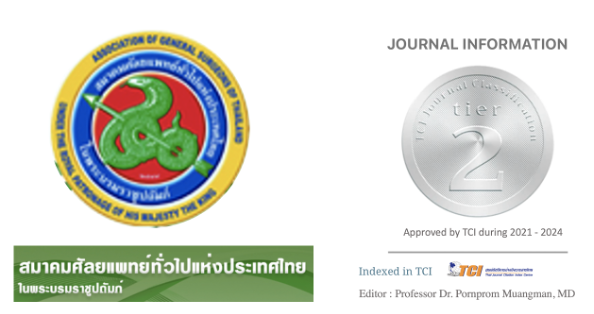Surgical outcome and prognostic factors of amputation in patients with below-the-knee (BTK) and Below-the-ankle (BTA) arteries bypass surgery in Nakornping Hospital, Thailand
Keywords:
infrapopliteal occlusive disease, critical limb ischemia, arteries bypass surgery, below-the-knee arteries bypass, below-the-ankle arteries bypass, peripheral arterial diseaseAbstract
Abstract:
Background: A surgical bypass of infrapopliteal disease was poor outcome due to high resistance, small target vessel and need of specific vein conduits, especially in Below-the-Ankle (BTA) arteries bypass. However, BTA arteries bypass cannot avoid to performing in some situation such as poor leg level tibial run-off arteries. Aim of study to compare surgical outcome between Below-the-Knee arteries bypass (BTK) and BTA arteries bypass and analyze prognostic factors that affective to amputation risk in patients with infrapopliteal occlusive disease.
Material and Method : Patients who received BTK and BTA surgical bypass at Nakornping hospital between January 2018 and July 2020 were included in study. Amputation rate, graft patency and mortality were retrospective review and analyses as surgical outcome. All prognostic factors of limb loss were analysed to identify risk of amputation.
Result : 23 patients of infrapopliteal occlusive disease were included in study. There were 11 patients in BTK bypass and 12 patients in BTA bypass. The etiology of occlusive disease included vascular trauma , acute limb ischemia and chronic arterial occlusion. BTA bypass tended to higher amputate rate than BTK group. (33% vs 18%, risk ratio (RR) 1.83; P-value =0.408). Mean primary patency of bypass graft in patients with BTA bypass was lower than BTK bypass group without statistically significant difference (44.63 ± 15.6 weeks vs 49.93 ± 14.0 weeks, Hazard ratio (HR) = 1.76, 95% confidence interval (CI) = 0.32-9.62; P-value = 0.514). Overall death was not statistically significant difference (0% vs 9.1% in BTA and BTK groups, respectively; P-value = 0.286). The prognostic factors of amputation including chronic kidney disease comorbidity, graft patency and acute graft thrombosis (P-value =0.009, 0.050 and 0.002, respectively). Mean grafts patency were 62.62 ± 11.9 weeks and 3.37 ± 2.3 weeks in limb salvage and amputation groups, respectively. Type of conduits had a tended to be increase amputation risk when non-vein graft materials such as composite graft, polytetrafluoroethylene (PTFE) with vein cuff and PTFE were chosen for bypass procedure. (P-value = 0.078)
Conclusion: There are no significant difference in surgical outcome including amputation rate, graft patency and mortality rate between BTK and BTA bypass but tended to increase amputation rate in BTA group. Type of conduits by using of vein graft, especially in reverse saphenous vein graft was a correctable factor that may decreased the risk of amputation. The authors offer the BTA bypass to revascularization if indicated to avoid major amputation in poor run-off vessel at leg level tibioperoneal arteries.




